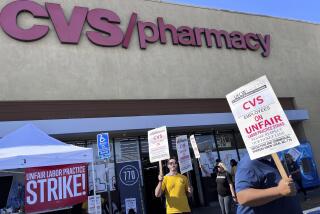Bitter Pill : Mom-and-Pop Druggists Say HMOs May Be Death of Them
- Share via
Jim and Benla Bennett draped the counter of their 88-year-old Downtown Los Angeles pharmacy in black cloth Wednesday. Two San Fernando Valley pharmacies staged mock funerals. And in New York, 200 pharmacists in black arm bands and their customers rallied at Times Square.
The mourning attire aimed to make the point that independent pharmacies are in a life-or-death struggle with health insurance companies. Lower drug prices sought by consumers often spell disaster for small pharmacies, whose plight was dramatized Wednesday by the National Assn. of Retail Druggists in demonstrations across the country.
More than 2,000 independently owned pharmacies nationwide have closed in the last year. The Bennetts and other druggists fear they may be next and hope their customers care enough about the personal attention and convenience they provide to pressure health care companies for reforms.
Health plans often do not cover the wholesale cost of drugs, the druggists say, or they require plan members to use special network pharmacies, cutting off patronage of mom-and-pop stores. The plans “don’t even pay pharmacists the cost of the medicine,” Benla Bennett complained.
Even large drugstore chains are complaining about the practices. Members of the National Assn. of Chain Drug Stores participated in Wednesday’s demonstrations, said Phillip Schneider, a spokesman for the 160 chains represented by the group.
“We’re all faced with the same kind of problems related to the dictates of large insurance providers,” Schneider said.
Chief among the concerns of druggists is that insurance companies encourage drug makers to provide price discounts for HMOs, plan hospitals and mail-order pharmacies. The discounts are unavailable to independents and even chain drugstores, Schneider said.
And insurance plans direct patients to certain network drugstores or to mail-order pharmacy companies. The practice in effect shuts out independent stores, said Charles West, executive vice president of the retail druggists association.
Finally, health insurance company reimbursement costs for drugs are set so low that the average pharmacy nets only 50 cents per prescription, according to the druggist groups, far less than is needed to cover pharmacy operating and overhead costs.
David Breslow, of the 1,300-member California Pharmacists Assn., said his group suspects the practice of below-cost pricing is being used to drive independent pharmacies out of business. A lawsuit filed by the association against half a dozen HMOs was settled out of court this summer, but the price structures remain unchanged, association attorney John Cronin said. The HMOs deny engaging in unfair practices.
Health insurers say the problems faced by pharmacies are just another facet of changes over the past 10 years in the health care industry. The competitive marketplace has affected hospitals, doctors, pharmacies and every aspect of the health care delivery system, said Mike Odom, a spokesman for Blue Shield of California.
“It’s easy to be sympathetic with the desires of community druggists to remain in business, but the business is driven by the market and the market is driven by consumers and consumers want lower prices,” said Richard Coorsh, a spokesman for the Health Insurance Assn. of America.
Health plans have turned to large discount stores, have demanded lower prices for drugs and use mail-order pharmacies to cut costs, Coorsh said. Employee health care costs declined last year for the first time in 20 years, he said.
Added Delbert Konnor, executive vice president of the American Managed Care Pharmacy Assn.: “The independents have to come to grips with the fact that things are changing in the marketplace.” The association, which represents 17 mail-order pharmacy houses, has seen the mail-order drug business grow from $100 million in sales in 1981 to an expected $8 billion this year, Konnor said.
Industry changes have already taken their toll on pharmacists such as the Bennetts. They say that as more of their customers switch to HMOs, they doubt they will be able to stay in business.
“In 1998 my lease is up,” Jim Bennett said. “But I don’t know if I’ll still be in business. . . . I may have to close the doors before that.”
More to Read
Inside the business of entertainment
The Wide Shot brings you news, analysis and insights on everything from streaming wars to production — and what it all means for the future.
You may occasionally receive promotional content from the Los Angeles Times.










